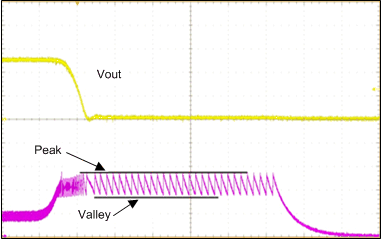SNAS660D June 2015 – May 2021 LM53600-Q1 , LM53601-Q1
PRODUCTION DATA
- 1 Features
- 2 Applications
- 3 Description
- 4 Revision History
- 5 Device Comparison
- 6 Pin Configuration and Functions
- 7 Specifications
- 8 Detailed Description
- 9 Applications and Implementation
- 10Power Supply Recommendations
- 11Layout
- 12Device and Documentation Support
- 13Mechanical, Packaging, and Orderable Information
Package Options
Mechanical Data (Package|Pins)
- DSX|10
Thermal pad, mechanical data (Package|Pins)
- DSX|10
Orderable Information
8.3.3 Current Limit
The LM53600-Q1 and LM53601-Q1 devices use two current limits which allow the use of smaller inductors than systems utilizing a single current limit. A coarse high side or peak current limit is provided to protect against faults and saturated inductors. High side current limit limits the duration of high sides FET's on period during a given clock cycle. A precision valley current limit prevents excessive average output current from the Buck converter of the LM53600-Q1 and LM53601-Q1 devices. A new switching cycle is not initiated until inductor current drops below the valley current limit. This scheme allows use of inductors with saturation current rated less than twice the rated operating current of the LM53600-Q1 or LM53601-Q1.
 Figure 8-3 Current Limit Operation
Figure 8-3 Current Limit OperationFigure 8-3 shows the response of the LM53600-Q1 or LM53601-Q1 device to a short circuit: Peak current limit prevents excessive peak current while valley current limit prevents excessive average inductor current. After a small number of cycles, hiccup mode is activated.